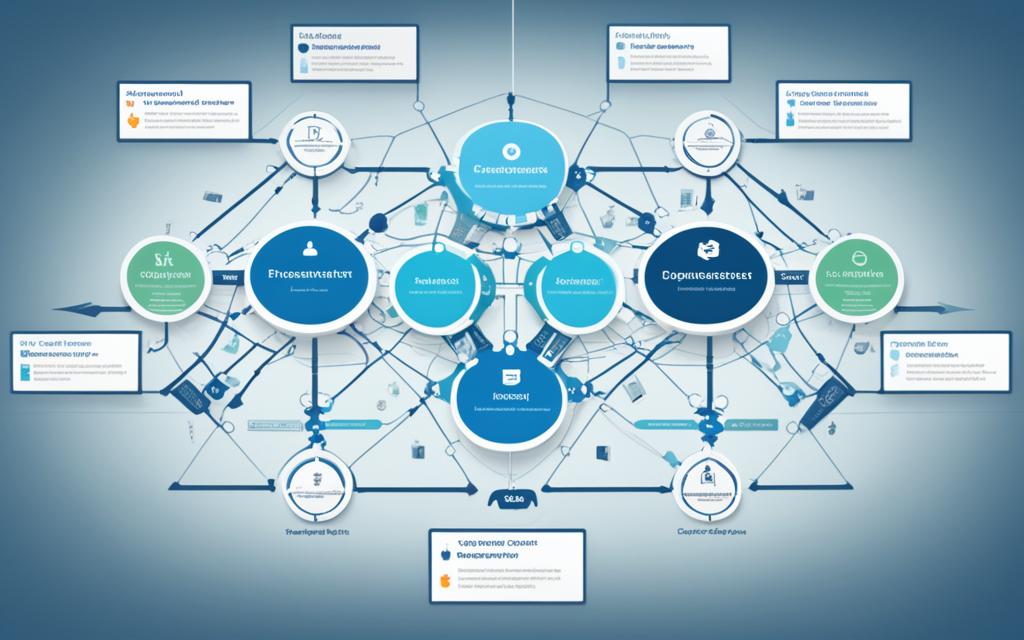Network segmentation is key for businesses to boost security and performance. It makes managing the network easier by breaking it into smaller parts. This way, network segmentation keeps sensitive data safe and stops malware from spreading.
Segmenting a network has many benefits. It makes it harder for hackers to attack and keeps important data safe. Recent data shows that segmenting can greatly reduce the risk of attacks1. This is crucial as data breaches now cost a record high of $4.24 million USD2.
Another advantage is better monitoring and finding threats. By breaking the network into smaller parts, it’s easier to watch over it and spot dangers. This makes it simpler to keep an eye on network traffic and find threats1.
But, it’s important to segment the network the right way. Too much segmentation can make things too complicated. Not enough can mean it doesn’t work well21.
There are different ways to segment a network, like using VLANs, firewalls, or SDN. Each method has its own benefits and things to consider. The best choice depends on what the organization needs and its setup.
Key Takeaways:
- Network segmentation is key for better security and performance1.
- Segmenting a network makes it harder for hackers to move around1.
- Too much or too little segmentation can cause problems21.
- Using the principle of least privilege helps keep the network safe2.
- Regular checks for security risks are important in a segmented network1.
What is Network Segmentation?
Network segmentation is a way to make networks safer by dividing them into smaller parts. Each part has its own access and security, adding an extra layer of protection. This stops cyber attacks from spreading and keeps important data safe.
This method makes it harder for hackers to move around and reduces the damage they can do3. It also has many other benefits.
Enhanced Network Performance
Breaking down a big network into smaller parts helps with traffic flow. This makes the network work better, especially for things like video calls3.
Cost Reduction
Using network segmentation can cut down on costs related to following rules. With fewer systems to manage, it’s easier and cheaper to keep up with rules3.
Improved Security
It limits how far a security issue can go by keeping threats in one area. This makes the network safer and reduces the chance of data theft3. Even if one part of the network is attacked, others stay safe.
Finding the right balance in network segmentation is key. Too many segments can make it hard to see what’s going on in the network. It’s important to think about what you need for security and how many segments are best3.
Automation is very important for network segmentation. It makes setting up and managing segments easier and less prone to mistakes3.
VLAN Segmentation
VLAN segmentation is a key method in network management. It breaks a big network into smaller, easier-to-manage parts called virtual local area networks (VLANs). This helps in keeping devices in the same group and makes managing the network and keeping it secure easier.
With VLAN segmentation, network managers can make many virtual networks in one physical setup. Each VLAN is like its own world, with its own subnet and IP addresses. Devices in the same VLAN talk to each other easily. But, they need a special device to talk to devices in other VLANs.
VLANs make managing and securing networks better. They are more stable and give better access than old subnets. Devices in a VLAN don’t have to find IP addresses all the time, which makes connecting faster and reduces delays.
Also, VLANs make networks more secure by limiting who can talk to whom. By putting devices into VLANs, managers can set up rules and keep data safe from unauthorized access.
“The average cost of a data breach is $4.35 million.”4
Using VLANs or subnets for network segments has big benefits. It makes checking for compliance easier and cheaper. By breaking the network into smaller parts, it’s easier to focus on each part’s compliance.
VLANs also make managing the network simpler. They are set up on switches and are easy to change. Subnets can be set up in hardware or software and are changed at the IP level.
It’s important to know that VLANs are for internal networks within one physical network. Subnets help devices talk to the outside world.
“Network segmentation reduces the attack surface by splitting the network into smaller subnetworks, leading to a localized impact of attacks before they can spread.”3
To use VLAN segmentation well, network managers give VLAN IDs to switch ports or devices. Basic VLANs use simple IDs, while extended VLANs have more features like priority routing. Tagged VLANs let you make many VLANs using the IEEE 802.1Q standard.
VLAN segmentation is a key part of network security. It helps protect against risks and security issues. It also makes the network work better.
Automating VLAN setup and management can lower the chance of mistakes in setting up network segments.
“Automating the configuration and management of network segments can reduce the risk of human errors in implementing network segmentation strategies.”3
Benefits of VLAN Segmentation
Using VLAN segmentation in networks has many advantages:
- It makes networks more secure by limiting who can talk to whom, reducing unauthorized access and data breaches.
- It makes checking for compliance easier and cheaper by focusing on smaller parts of the network.
- It improves network performance by making connections faster and reducing delays.
- It makes managing the network easier with flexible and simple setup options.
VLAN segmentation strengthens network security, makes compliance easier, and ensures the network works well.
Image
Firewall Segmentation
Firewall segmentation is key to a strong network security plan. It divides a network into safe parts, each with its own firewall. This way, sensitive data stays protected and unauthorized access is blocked.
To set up firewall segmentation, firewalls are placed between different parts of a network. This makes sure every part of the network goes through a firewall. It’s like having a guard at every entrance.
Firewalls control who can enter by checking traffic types. They use access controls to decide if traffic is allowed. This means only certain traffic gets through, keeping data safe.
Firewall segmentation boosts security and makes networks run better. It stops unwanted traffic, lowering the chance of security problems. This makes networks work more smoothly.
But, setting up firewall segmentation can be hard and costly. If done wrong, it can cause problems with apps and leave networks open to attacks. So, it’s important to have the right skills and resources for it.
Key Statistics:
- About 20% of a security specialist’s work is dealing with network segmentation issues5.
- Using a network-centric approach to segmentation means keeping up with new threats by updating access rules6.
| Firewall Segmentation Benefits | Statistical Data |
|---|---|
| Enhances cybersecurity | Segmenting a network improves security by controlling access, boosting performance, and strengthening defenses7. |
| Reduces the risk of unauthorized access | Segmenting a network lowers the chance of unauthorized access and helps stop breaches7. |
| Simplifies compliance | Segmenting networks makes following rules, like PCI DSS, easier by isolating sensitive data7. |
| Supports security and business objectives | Segmented networks reduce congestion, improve user experience, and help with both security and business goals7. |
In summary, firewall segmentation is vital for strong network security. It uses access controls and blocks traffic to keep networks safe, efficient, and secure from unauthorized access and breaches.
SDN Segmentation
SDN segmentation is a new way to manage networks using software. It creates virtual network segments and automates traffic flow. This approach lets network admins manage the network from one place, making it more secure and efficient.
SDN segmentation is a smart way to control network traffic. It uses software-defined policies to route data through firewalls. This ensures data goes to the right places securely. It also makes the network faster and less prone to human mistakes.
In cloud settings, SDN segmentation is very useful for security and following rules8. It automates and enforces policies, making it quick to add new servers or security groups. This boosts speed and lowers security risks.
SDN segmentation lets you tag security groups and apps with labels8. These labels help in making security policies clear and specific for cloud segments. This way, security can be applied based on what each segment needs.
SDN segmentation also merges security controls for both physical and cloud networks8. This means organizations can protect their assets in all environments with one security policy. It provides full protection across the board.
However, adding SDN segmentation might be tricky in some cases8. While it has many benefits, it’s important for organizations to check if it fits their network setup and goals.
Benefits of Network Segmentation
Network segmentation offers many advantages for companies. It helps stop cyber attacks from spreading by limiting their reach and stopping them from moving laterally9. It also boosts security by controlling who can access the network from inside and outside9. By breaking the network into smaller parts, the damage from a cyber attack is greatly reduced9.
Segmenting networks by function or team helps stop cyber threats from spreading across the network10. This way, if a breach happens, it stays within one area10.
Network segmentation also makes the network run smoother and faster10. It reduces traffic jams and speeds up connections in each part of the network. This is great for companies with lots of users and devices10. Plus, it makes it easier to keep an eye on the network and spot threats10.
Segmenting the network also protects sensitive data10. If one part of the network is breached, the rest stays safe. This is crucial for companies dealing with private or sensitive information10. It also helps meet rules like the Payment Card Industry Data Security Standard (PCI DSS), which requires network segmentation for sensitive data10.
Network segmentation follows the principle of least privilege, limiting access to sensitive areas9. This is easier with a segmented network9. If an attack does happen, it’s limited to one area, keeping others safe9.
There are different ways to segment a network, each with its own benefits and things to consider10. Physical segmentation uses hardware to separate networks, while logical segmentation uses software like VLANs and VPNs10. Both have their pros and cons, with physical offering dedicated hardware and logical being more flexible but costing less10. But, it’s important not to segment too much to avoid making network management hard11.
In summary, network segmentation is very beneficial for companies. It helps control cyber attacks, improves security, makes traffic flow better, protects data, and follows rules10. By using network segmentation, companies can boost their security, keep sensitive info safe, and reduce cyber threat risks.
Network Segmentation vs. Micro-Segmentation
Network security is crucial, and both network segmentation and micro-segmentation are key. They protect sensitive data and stop unauthorized access. Each method offers different levels of control and safety, tackling unique security issues. Let’s look at how they differ and their benefits.
Network Segmentation: Limiting North-South Traffic
Network segmentation splits a network into separate parts or VLANs, controlling traffic flow between them12. It’s great for managing and securing the traffic coming in and out of the network. By doing this, companies set up barriers between different network areas, adding an extra layer of safety. This method is seen as a top way to protect operational technology from threats12.
Micro-Segmentation: Enhancing East-West Protection
Micro-segmentation takes a detailed approach to network security within a network zone. It focuses on east-west traffic, which is data moving laterally in the network13. Using virtualization and SDN, it breaks down network segments to the level of apps or workloads14. This method sets strict rules to stop attackers from moving laterally and limits breaches within the network14. It makes security better by isolating sensitive data and systems into secure segments, meeting regulatory needs14.
Complementary Security Strategies
Network segmentation and micro-segmentation are both key for strong network security. Together, they form a layered defense that goes beyond just one approach14. Segmentation sets the main security rules, controlling access between zones. Micro-segmentation adds more detail and control within those zones14. This mix stops unauthorized access and limits movement in the network, reducing the risk of cyberattacks1413.
In summary, network segmentation and micro-segmentation are essential for a full network security plan. Segmentation controls north-south traffic, while micro-segmentation focuses on east-west protection. Using both practices prevents unauthorized access, limits movement, and boosts security for companies1413.
Top 8 Best Network Segmentation Practices
It’s key to make your network secure by segmenting it. To do this well, follow these eight top practices:
- Continuously monitor and audit networks: Keep an eye on your networks to spot weaknesses and keep them secure15.
- Avoid over-segmentation: Segmenting is good, but don’t overdo it. Too many segments can make things complicated and leave security holes15.
- Limit third-party access: Keep outsiders from getting in by controlling who can access your network. This lowers the chance of security issues15.
- Identify and label asset values: Know what’s important in your network for better security planning. Labeling assets helps you focus on what needs the most protection15.
- Combine similar network resources: Grouping things like servers and apps together makes managing and securing them easier15.
- Implement endpoint security: Protect devices on your network with strong endpoint security to fight malware and unauthorized access15.
- Follow the principle of least privilege: Give users only what they need to do their jobs to stop unauthorized actions and shrink the attack area15.
- Create comprehensive network diagrams: Detailed diagrams help show your network’s layout and spot possible weak spots or mistakes15.
Using these practices, you can make a strong network segmentation plan. This keeps your data safe, boosts security, and meets legal standards.
References:
- ninjaone.com – Network Segmentation Best
- phoenixnap.com – Network Segmentation Security
- spiceworks.com – Network Segmentation
Network Segmentation Implementation Strategy
Implementing network segmentation needs a detailed plan. This plan should tackle an organization’s security risks and boost its network strength16. First, a deep check of the current setup is needed to spot weak spots16. This helps companies see their security threats and figure out how many network segments they need to fix these issues.
Getting ready means looking at the data moving through the network17. Data that’s very sensitive, like customer info or research, needs extra protection. This is to follow rules and protect against data breaches17.
It’s key to map out how data moves in the network17. This means looking at data coming in and going out, plus what moves around inside. Knowing this helps companies set up their network segments right. It makes sure data moves safely and efficiently between segments17.
Gradual Transition and Auditing Infrastructure
Planning a step-by-step approach is crucial to avoid disrupting work or partnerships16. Doing it in phases lets companies put in network segmentation smoothly. They can focus on high-risk areas and functions first, making sure everything goes smoothly and stays secure.
Checking the network regularly is key to keeping network segmentation working well17. Regular audits spot any missing pieces or weak spots in the setup. This lets companies make changes to keep their security strong17.
Documentation for Effective Implementation
Good documentation is crucial for making network segmentation work16. It outlines the steps for setting it up, helps with checks and following rules, and makes fixing problems easier. Having clear and detailed documents makes sure everything stays consistent and clear. It also helps with making changes and updates later on.
By using a clear plan for network segmentation, companies can tackle security risks and boost their network security1617. With careful planning, checking the setup, a step-by-step approach, and detailed documents, companies can protect their important data and lower the chance of unauthorized access or data breaches1617.
Network Segmentation Best Practices to Strengthen Security
Effective network segmentation means using best practices to boost security. These methods help protect against cyber threats. They make the network safer overall.
- Follow the principle of least privilege: Give users and devices only what they need. This lowers the risk of unauthorized access and breaches1.
- Limit third-party access: Too much power given to outsiders can lead to data breaches. Watch over and control the access given to others2.
- Audit and monitor the network: Check and watch the network often to spot strange actions or security weak spots1.
- Make legitimate paths to access easier: Make it simple for real users and devices to get into the network. This way, it’s harder for unauthorized people to get in1.
- Combine similar network resources: Put together network resources that need the same level of security. This makes security rules easier to set and manage. It also makes things simpler and less complex1.
Using these network segmentation tips helps create a strong security setup. It controls cyber attacks, reduces damage, and improves how we check for threats1. By doing this, companies can keep their important data and systems safe. This ensures a secure network for everyone.
Conclusion
Network segmentation is key to keeping networks safe from cyber threats. It breaks the network into smaller parts to protect sensitive data. This way, if one part gets hit by a security issue, it won’t spread to the whole network18.
Many rules like GDPR, HIPAA, and PCI DSS say you must do this to keep data safe18. It also makes the network run smoother by controlling how much data moves around18. Plus, it stops insiders from getting into things they shouldn’t by controlling who can see what18.
But, setting up network segments can be tricky. You need to make sure only the right people can get in and talk to each other18.
To make it work, follow the best steps. This means giving people only what they need, keeping outsiders out, and always checking on your network19. Also, having a network that’s easy to navigate and secure is key19.
Using the right tools like VLANs, firewalls, and NAC solutions helps a lot18. This way, you can stop data breaches and keep malware out19. Knowing how VLANs and switch security work helps network experts set up strong segments20.
In short, making your network safe is all about segmenting it right19. It keeps data safe, makes the network run better, and fights off threats18. By using the best methods and tools, you can make a network that’s strong against cyber attacks19.
FAQ
What is network segmentation?
Network segmentation is a way to make networks safer and run better. It breaks the main network into smaller parts. This makes security stronger, speeds things up, and makes managing the network easier.
How does network segmentation improve security?
It adds more protection by having separate access points and firewalls for each part of the network. This stops cyber attacks from spreading and keeps important data safe.
What are the main ways to segment a network?
You can segment a network using VLANs, firewalls, or SDN.
What is VLAN segmentation?
VLAN segmentation creates smaller groups within a network. Each group has its own IP address. Devices in different groups can’t talk to each other without going through a special device.
How does firewall segmentation work?
Firewalls are set up between different parts of a network. They control what kind of data can go through. This adds an extra layer of safety.
What is SDN segmentation?
SDN segmentation uses software to manage a network. It lets administrators control the network from one place and manage traffic automatically. This makes it easier to keep data safe by using firewalls.
What are the benefits of network segmentation?
Network segmentation makes networks safer by stopping cyber attacks from spreading. It also makes it easier to control who can access the network. It helps with managing traffic, finding threats, and keeping sensitive data safe.
What is the difference between network segmentation and micro-segmentation?
Network segmentation controls traffic between networks or VLANs. Micro-segmentation protects within a network. Network segmentation is a broad strategy, while micro-segmentation is more detailed.
What are the best network segmentation practices?
Good practices include keeping an eye on the network, not over or under-segmenting, and limiting access to outsiders. It’s also key to group similar resources, secure endpoints, and follow the least privilege rule. Detailed network diagrams are also important.
How should network segmentation be implemented?
Start with a clear plan that looks at security risks and checks the current setup. Move to a segmented network step by step. Keeping detailed records is crucial for tracking progress and making changes later.
What are the best network segmentation practices to strengthen security?
To boost security, follow the least privilege rule and limit outsider access. Regularly check the network and make sure the right people can get in easily. Grouping similar resources together also helps.
Why is network segmentation important for network security?
It’s key for making networks safer by breaking them into smaller parts. This strengthens security, improves traffic flow, and protects important data. By using segmentation and best practices, networks can stay safe from cyber threats.
Source Links
- https://www.upguard.com/blog/network-segmentation-best-practices – Top 8 Network Segmentation Best Practices in 2024 | UpGuard
- https://www.strongdm.com/blog/network-segmentation – 7 Network Segmentation Best Practices to Level-up | StrongDM
- https://www.timusnetworks.com/blog/network/network-segmentation-what-does-it-entail-and-why-is-it-crucial/ – Network Segmentation: What Does it Entail and Why is it Crucial?
- https://www.algosec.com/blog/network-segmentation-vs-vlan/ – Network Segmentation vs. VLAN Explained | AlgoSec
- https://community.spiceworks.com/t/has-network-segmentation-been-a-priority-to-your-network-s-security/744088 – Has network segmentation been a priority to your network’s security?
- https://www.crowdstrike.com/cybersecurity-101/network-segmentation/ – What is Network Segmentation? – CrowdStrike
- https://www.tufin.com/blog/unlocking-benefits-network-segmentation-key-enhanced-cybersecurity – Unlocking the Benefits of Network Segmentation: A Key to Enhanced Cybersecurity | Tufin
- https://www.tufin.com/blog/cloud-network-segmentation – Cloud Network Segmentation: Mission Impossible? | Tufin
- https://www.colocationamerica.com/blog/security-benefits-of-network-segmentation – The Benefits of Being Secure with Network Segmentation
- https://nilesecure.com/network-security/what-is-network-segmentation-how-it-works-why-it-matters – What Is Network Segmentation? How It Works & Why It Matters | Nile
- https://www.connectwise.com/blog/rmm/network-segmentation – Network Segmentation: Definition, Examples & More | ConnectWise
- https://www.fortinet.com/resources/cyberglossary/ot-network-segmentation-and-microsegmentation – OT Network Segmentation and Microsegmentation Guide | Fortinet
- https://faddom.com/a-beginners-guide-to-micro-segmentation-and-network-microsegmentation/ – Micro Segmentation & Network Microsegmentation Beginners Guide
- https://truefort.com/macro-segmentation-micro-segmentation/ – Macro Segmentation vs. Micro Segmentation • TrueFort
- https://www.ninjaone.com/blog/network-segmentation-best-practices/ – Top 8 Network Segmentation Best Practices | NinjaOne
- https://www.threatintelligence.com/blog/network-segmentation – Network Segmentation and How it Can Prevent Ransomware
- https://www.checkpoint.com/cyber-hub/network-security/what-is-network-segmentation/network-segmentation-security-best-practices/ – Network Segmentation Security Best Practices – Check Point Software
- https://pecb.com/article/navigating-the-network-segmentation-vs-segregation – Navigating the Network: Segmentation vs. Segregation
- https://www.zenarmor.com/docs/network-basics/network-segmentation – What Is Network Segmentation? Introduction to Network Segmentation – zenarmor.com
- https://www.infosecinstitute.com/resources/management-compliance-auditing/vlan-network-chapter-5/ – Exploring VLAN Security: Importance & Fundamentals



















